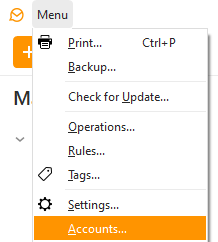


- #EM CLIENT SUPPORT SYNCING CONTACTS WITH EXCHANGE INSTALL#
- #EM CLIENT SUPPORT SYNCING CONTACTS WITH EXCHANGE ANDROID#
- #EM CLIENT SUPPORT SYNCING CONTACTS WITH EXCHANGE PC#
- #EM CLIENT SUPPORT SYNCING CONTACTS WITH EXCHANGE WINDOWS#
Search for tbsync and then add each of the following add-ons: 1) TbSync and 2) Provider for Exchange ActiveSync. To make the EAS connection, you will need to enter your groupware server name, email address and password.Īfter you get it installed, you can get the TbSync Add-on by clicking the menu icon and clicking Add-ons / Get Add-ons.
#EM CLIENT SUPPORT SYNCING CONTACTS WITH EXCHANGE INSTALL#
By default, Thunderbird supports POP3 and IMAP connections for email, and using IMAP you can sync your email to your preferred IMAP mail server. To synchronize calendars and contacts, all you have to do is install a simple little Thunderbird Add-on called TbSync which uses EAS and/or CalDAV/CardDAV protocols to connect to your Groupware server. Thunderbird might actually be the first and oldest Outlook alternative, and it also provides a stable EAS solution. And while most of these modern clients support Exchange, most of them do not include support for EAS. Enter Mozilla Thunderbird. There are lots of desktop email clients – emClient, BlueMail, and Mailbird to name a few. Contact type: Select Mail contact from the drop-down list. Click + Add a contact and configure the following settings in the details pane. In the new EAC, go to Recipients > Contacts.
#EM CLIENT SUPPORT SYNCING CONTACTS WITH EXCHANGE PC#
That move left many desktop PC users looking outside the box alternatives to Outlook. Use the Exchange admin center to manage mail contacts Use the new EAC to create mail contacts.
#EM CLIENT SUPPORT SYNCING CONTACTS WITH EXCHANGE WINDOWS#
And while most mobile apps (Bluemail, BlackBerry Hub, Outlook and Gmail) work nicely with Exchange ActiveSync, the same unfortunately cannot be said for Windows desktop clients.Īs a result of performance issues, Microsoft discontinued support for Exchange ActiveSync (EAS) in Outlook 2016 making it difficult to sync email, calendars and contacts. Learn about MailTips, the informative messages displayed to users while they're composing a message.We look at lots of email clients and mobile apps. On enrolled devices, the exported Outlook contacts are considered unmanaged and are accessible to unmanaged, personal apps. Learn about Outlook on the web, which provides users access to their Exchange mailbox through a web browser. On enrolled devices, in order to leverage Outlook’s contact export process, several changes to device restrictions are required, as documented in Support Tip: Enabling Outlook iOS Contact Sync with iOS12 MDM Controls. Learn about how the integration of Office Online Server helps provide rich attachment preview functionality in Outlook on the web. Install Office Online Server in an Exchange organization
#EM CLIENT SUPPORT SYNCING CONTACTS WITH EXCHANGE ANDROID#
Learn about the Outlook for iOS and Android app and how it allows your users to securely access their mailbox data remotely with their iOS and Android devices. Learn about how users can access their Exchange mailbox by using email programs that use POP3 or IMAP4. em client supports mfa/oauth login, but the pop. em client > 8.2 and newer do not need this solution, as it is included > natively. Using Exchange ActiveSync, users can access email, calendar, contact, and task information. attention: these solutions can only work with em client 8.0 - 8.1, > they will not work for legacy versions of em client. Learn about the protocol that provides connectivity to a wide variety of mobile phones and tablets. (This feature was formerly known as RPC/HTTP.) Learn about the earlier client access method that provides connectivity to Outlook. Learn about the latest client access method that provides connectivity to Outlook. The following table contains links to topics that will help you learn about and manage some of the clients and client access methods that you can use to access your Exchange mailbox. Each of these clients offers a variety of features. These clients include desktop programs such as Outlook, Outlook on the web (formerly known as Outlook Web App), and mobile clients such as mobile phones, tablets, and other mobile devices. There are many different clients that you can use to access information in an Exchange mailbox.


 0 kommentar(er)
0 kommentar(er)
